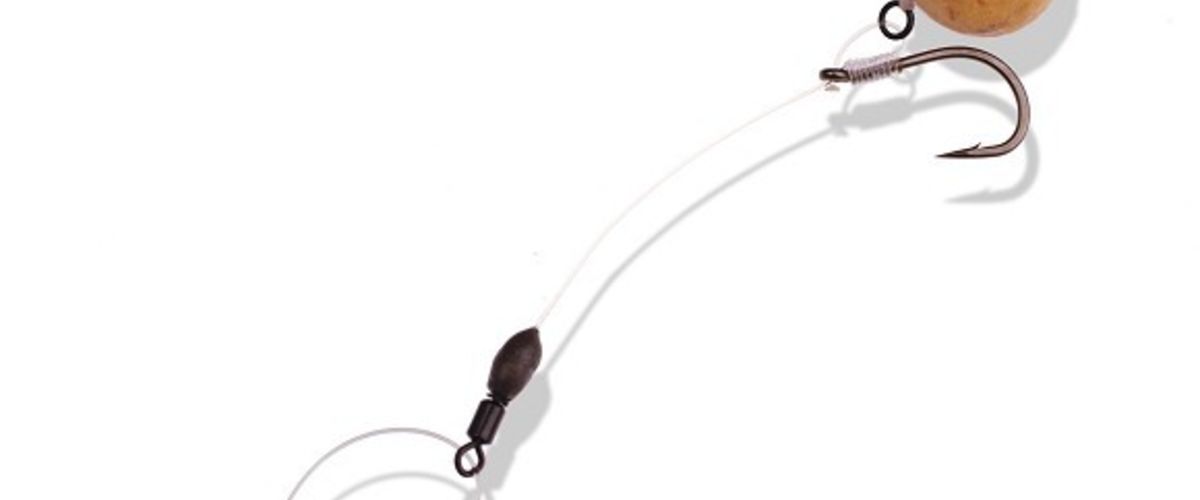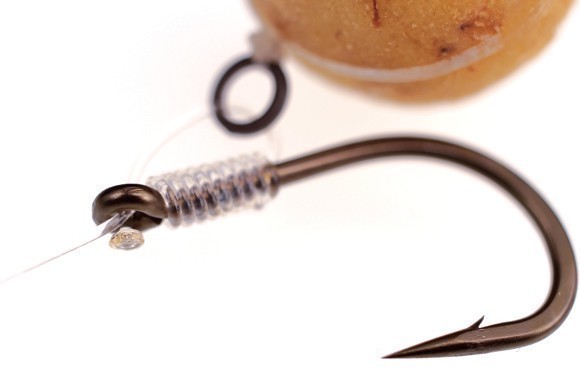
The Mega Rig Plan
Four rigs, four different uses, one end result: big fish nailed. Gardner Tackle’s Lewis Read explains…
The Hinged Stiff Link
Can I ever envisage myself not using this rig? Well, certainly not at the moment. The important aspects of the rig have changed very little over the years (mainly just adaptations due to new materials) but the important details haven’t.
Hook sections tend to be made with stiff monofilament – in this case mine are tied using 20lb Trip Wire and given a gentle curve so the hook rotates easier, whatever direction the carp approaches from. I have found that an acutely angled/curved hook section requires more force to turn and closes up the hook gape increasing the angle between hook point and the direction the hook needs to penetrate.
Boom sections are no longer that ‘forgetful mono’, I can get better results using a decent fluorocarbon (normally something like 30lb Mirage) or our purpose-made Tricklink, simply because they are far better materials in terms of their camouflage across a range of lakebeds. Talking of which, I really rate this rig fishing in clean silt and just push the silicon stop of the helicopter up a few inches to compensate for the soft drop.
If you get all the elements right – nice tidy, strong loop knots; the ‘D’ nice and straight on the back of the hook shank; steaming the boom straight – and you end up with a rig that presents your hookbait perfectly and resets itself if a fish disturbs the terminal tackle whilst feeding (or even if it rejects the hookbait forcibly). It’s still the Daddy rig…



The Clone Rig (Aka Stiff Rig)
This is possibly the most consistent bottom bait rig I have seen used across almost all of the venues that I have fished. Its simplicity belies its effectiveness!
Think of it like an elongated Hinged Stiff Rig hook section or Chod Rig. ‘The Clone’ (local name) is ideal for fishing with bottom baits or balanced bottom baits (i.e. cork plugged or snowman hookbaits) on almost any type of clean lakebed, though most people that I know that do well on the rig tend to put it on cleaned-off hard spots as this enables the monofilament to lie down flat and inconspicuously.
When it’s tied up at six- or seven-inches with either fluorocarbon or a decent mono (same as HSR boom sections), it’s a great tangle-free rig that resets itself well, and when it’s sucked in, the hook will inevitably go ‘in bed’ first and once it’s been inhaled into the carp’s mouth, the hook point is orientated correctly and tends to rotate so hook holds are positive.
As with any relatively high diameter monofilament rig, it’s well worth steaming straight and incorporating a loop at the swivel end to allow the rig to move and rotate freely and unhindered.
I always use this rig with our Incizor hooks – the straight eye creates a really nice angle with the hooklink coming through the inside of the eye (good old Knotless Knot) and I keep the exit of the hooklink straight by making sure the blobbed end of the ‘D’ sits inside the eye on the side of the hooklink that would otherwise cause a slight offset between hook and hooklink.
You don’t need to do loads of turns up the shank either – six or seven is more than ample. What you do need to do though, is make sure that after tightening down the knots you ensure the ‘D’ is sat nice and straight on the back of the shank.



Blow Back/Mugga
Emulated, but never successfully duplicated, the Mugga hook lends itself perfectly to use on a Blow Back rig, and as such is a bread and butter presentation that is pretty fool-proof. Why? Well, the whole point of the Blow Back rig is the fact that the rig ring on the shank can push down towards the eye of the hook if the fish tries to eject the hookbait and also the hook is able to pivot easier than with a standard off-the-shank Hair.
Thanks to the curved shank and aggressively angled eye, the hook has a tendency to react quickly when it’s in the fish’s mouth and if the fish tried to eject the hookbait, the hook point will tend to drop down in that fraction of a second as the ring slides to the hook eye (the angle of which helps maintain the best possible position of the hook point).
You can either use a skinned hooklink or a plain supple braid with this rig. The extra flexibility of the soft section ensures the hook can turn and flip unhindered. Several anglers in the Gardner team habitually add a little bit of Supa-Shrink tube to the hook, extending the length of the shank, and it’s a tweak well worth considering if you suffer from any hook pulls. The extension means the hook starts turning a few millimetres further inside the mouth than a plain hook. In honesty, I’ll always start without the additional tubing as it makes the hook look a lot more obvious laid on the lakebed.
Most of the time, with a bottom bait (balanced or otherwise) I’ll tie the rig so the ring on the shank is opposite the barb. This way the hook inevitably goes in bend first and if the hook goes in the right way round the hook is facing the right way to prick the fish straightaway.
Everything is right with this hooking arrangement; it always has been. You just adjust the length and strength of the hooklink to suit the individual situation.



The Foreign Special
Here’s one for anyone off on a jaunt to even warmer climes this summer. It’s a really effective rig that I tend to fall back on, on those rare occasions that I visit France to wet a line and it has never let me down yet.
It’s primarily a maize rig (I have a couple of tins of Scopex Maize left that are brought out of retirement just for this purpose) that allows me to present a relatively large hookbait in a delicate way, nice – despite it being attached to a dirty great gaff of a size 4 Incizor!
Using a good strong skinned hooklink (any of our 25lb hooklinks are utterly bullet-proof), I simply start off by tying a blow back style hookbait presentation on a piece of Disruption hooklink; but instead of a good old Mugga I incorporate an Incizor with a Covert Hook Aligner. Why? Well the Incizor is an extremely strong pattern that has a slightly longer shank than most similar hooks. The combined length of that shank and a Hook Aligner means that even a carp with a cavernous mouth is likely to get nailed if it inhales the hookbait.
The hookbait is a 12mm Carp Company Pineapple pop-up sandwiched between the scrumptious pieces of maize, the combination of which gives a partially balanced hookbait – that’s buoyant enough to nullify the weight of that big old hook. This actually looks quite subtle for a relatively big hookbait, which I think is just because rather than just being a string of just boilies or maize, the ‘sandwich’ looks less obvious – even though it is. This sandwich hookbait works with the longer Hook Aligner to enhance the hooking efficiency, due to the shape and buoyancy. Technically efficient and subtle, but still brutal enough to catch carp from pretty much everywhere.
*Note: why I haven’t used this presentation (in a more refined form) in this country? Gaw’d only knows! It works so well I really should have a serious play with it over here. There are loads of possible combinations of baits that could be used, bits of foam or cork in the sandwich, even using different particles either side. The world is your oyster…






